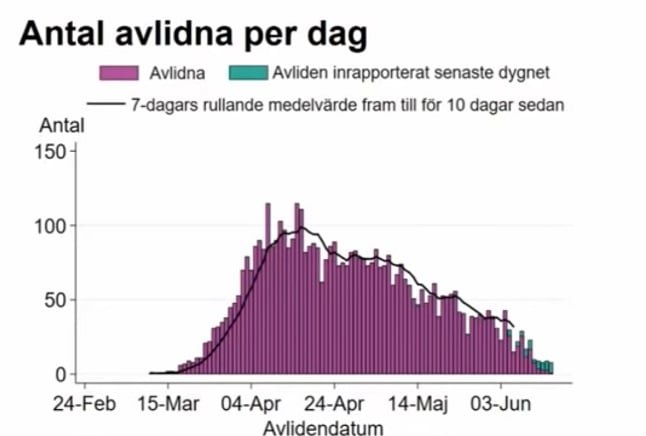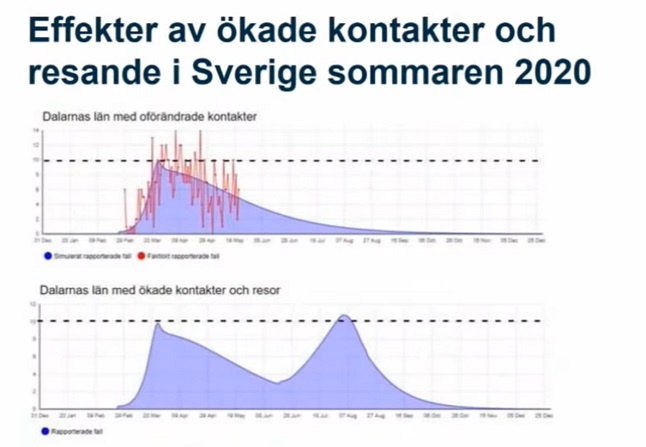Has Sweden passed its coronavirus peak yet?

Sweden continues to see a high rate of new infections and deaths linked to coronavirus. But has the country passed its peak, or is worse still to come?
"Sweden has reached its peak and is on the way down," said state epidemiologist Anders Tegnell at the Public Health Agency's press conference on Tuesday.
Tegnell also criticised international media for misrepresenting Sweden's coronavirus statistics.
The number of new reported cases has been increasing, but Tegnell said this was due to more people being tested for the virus and therefore more mild cases being discovered, where previously low testing rates meant only more serious cases or those in priority groups were reported.
"Unfortunately this has been interpreted in international media as a new increase and that we have not reached a peak. That is wrong. But of course, when you start to test more you also find more cases," he said.
-
Ten coronavirus rules you still have to (or should) follow in Sweden
-
Who's actually responsible for Sweden's coronavirus strategy?
At the same time, the European Centre for Disease Control (ECDC) wrote on Thursday that "The initial wave of transmission has passed its peak in all countries apart from Poland and Sweden".
The ECDC based this on the 14-day incidence of coronavirus, based on reported cases. Across the EU/EEA, the peak was on April 9th, with a fall of 80 percent in incidence since then, but in both Sweden and Poland it was at its highest level since the start of the outbreak. Sweden was the only country with more than 100 new confirmed cases per 100,000 inhabitants over the 14-day period before the report was written.
The centre did however note that "increases in testing in Sweden may partly explain this increase". Between May 25th to June 8th the number of individuals tested per week in Sweden almost doubled from 36,500 to 60, 678.
But how should we define a "peak" when we talk about infectious disease outbreaks?
"The safest way is to look at the number of case fatalities or the number of individuals newly entering intensive care units," Stockholm University mathematics professor Tom Britton, told The Local.
"Those are the most reliable measures, and there is a delay there, typically of about two to three weeks between getting infected and going to intensive care or dying, so if the number of case fatalities goes up, up, up and then down, down, down, the time at the maximum is the peak of fatalities, so peak transmission was more like three weeks before that," said Britton, who has worked on mathematical modelling around the coronavirus epidemic
This means that Sweden has, by these measures, passed the peak around a month ago.

A graph showing the number of deaths linked to coronavirus per day in Sweden, with the black line showing the seven-day rolling average. Image: Public Health Agency
Different regions are still in different phases of the pandemic, but Britton said case fatalities and new intensive care cases were on the way down in most parts of Sweden.
"I think Gothenburg for example may have their peak around now, whereas Stockholm had it more than a month ago. On a country level, the peak was reached around a month ago," he said.
Second wave?
That leaves the question of whether there will be a second wave of infections and therefore a second peak, something which partly depends on the extent to which people continue following the measures that have led to a fall in infections -- namely limiting social contacts and following good hand hygiene.
State epidemiologist Tegnell has warned that if people in Sweden failed to follow the guidelines in place, there was a risk the infection rate would rise again after Sweden lifted restrictions on domestic travel on June 13th.
"This is naturally a scenario that we absolutely want to avoid," he said on Tuesday.
Using the Dalarna region as an example, he explained: "If we continue as we're doing today, Dalarna will successively see fewer and fewer cases over the next few weeks and then the virus will ebb away."

But if domestic travel leads to a doubling of social contacts, increased spread of infection can be expected.
"It's a small [risk] if we continue to take responsibility through ensuring we aren't having lots of new contacts," Tegnell told the TT newswire.
Epidemiologist Björn Olsen, who has been critical of the Public Health Agency's strategy, told the Dagens Industri newspaper he thought a second wave was unlikely, but said it is likely the virus will be around for many years, with a risk of new clusters of cases if people fail to act responsibly.
"We're still in some kind of first wave, at the end of it. It's question of how quickly and abruptly that wave will end. There will be no second wave, but you might get a 'long tail' with dips and eruptions if this is not done correctly," he said.
Comments
See Also
"Sweden has reached its peak and is on the way down," said state epidemiologist Anders Tegnell at the Public Health Agency's press conference on Tuesday.
Tegnell also criticised international media for misrepresenting Sweden's coronavirus statistics.
The number of new reported cases has been increasing, but Tegnell said this was due to more people being tested for the virus and therefore more mild cases being discovered, where previously low testing rates meant only more serious cases or those in priority groups were reported.
"Unfortunately this has been interpreted in international media as a new increase and that we have not reached a peak. That is wrong. But of course, when you start to test more you also find more cases," he said.
-
Ten coronavirus rules you still have to (or should) follow in Sweden
- Who's actually responsible for Sweden's coronavirus strategy?
At the same time, the European Centre for Disease Control (ECDC) wrote on Thursday that "The initial wave of transmission has passed its peak in all countries apart from Poland and Sweden".
The ECDC based this on the 14-day incidence of coronavirus, based on reported cases. Across the EU/EEA, the peak was on April 9th, with a fall of 80 percent in incidence since then, but in both Sweden and Poland it was at its highest level since the start of the outbreak. Sweden was the only country with more than 100 new confirmed cases per 100,000 inhabitants over the 14-day period before the report was written.
The centre did however note that "increases in testing in Sweden may partly explain this increase". Between May 25th to June 8th the number of individuals tested per week in Sweden almost doubled from 36,500 to 60, 678.
But how should we define a "peak" when we talk about infectious disease outbreaks?
"The safest way is to look at the number of case fatalities or the number of individuals newly entering intensive care units," Stockholm University mathematics professor Tom Britton, told The Local.
"Those are the most reliable measures, and there is a delay there, typically of about two to three weeks between getting infected and going to intensive care or dying, so if the number of case fatalities goes up, up, up and then down, down, down, the time at the maximum is the peak of fatalities, so peak transmission was more like three weeks before that," said Britton, who has worked on mathematical modelling around the coronavirus epidemic
This means that Sweden has, by these measures, passed the peak around a month ago.

A graph showing the number of deaths linked to coronavirus per day in Sweden, with the black line showing the seven-day rolling average. Image: Public Health Agency
Different regions are still in different phases of the pandemic, but Britton said case fatalities and new intensive care cases were on the way down in most parts of Sweden.
"I think Gothenburg for example may have their peak around now, whereas Stockholm had it more than a month ago. On a country level, the peak was reached around a month ago," he said.
Second wave?
That leaves the question of whether there will be a second wave of infections and therefore a second peak, something which partly depends on the extent to which people continue following the measures that have led to a fall in infections -- namely limiting social contacts and following good hand hygiene.
State epidemiologist Tegnell has warned that if people in Sweden failed to follow the guidelines in place, there was a risk the infection rate would rise again after Sweden lifted restrictions on domestic travel on June 13th.
"This is naturally a scenario that we absolutely want to avoid," he said on Tuesday.
Using the Dalarna region as an example, he explained: "If we continue as we're doing today, Dalarna will successively see fewer and fewer cases over the next few weeks and then the virus will ebb away."

But if domestic travel leads to a doubling of social contacts, increased spread of infection can be expected.
"It's a small [risk] if we continue to take responsibility through ensuring we aren't having lots of new contacts," Tegnell told the TT newswire.
Epidemiologist Björn Olsen, who has been critical of the Public Health Agency's strategy, told the Dagens Industri newspaper he thought a second wave was unlikely, but said it is likely the virus will be around for many years, with a risk of new clusters of cases if people fail to act responsibly.
"We're still in some kind of first wave, at the end of it. It's question of how quickly and abruptly that wave will end. There will be no second wave, but you might get a 'long tail' with dips and eruptions if this is not done correctly," he said.
Join the conversation in our comments section below. Share your own views and experience and if you have a question or suggestion for our journalists then email us at [email protected].
Please keep comments civil, constructive and on topic – and make sure to read our terms of use before getting involved.
Please log in here to leave a comment.